Sally Murphy's Blog, page 28
July 11, 2018
ANZAC Day 2018 – an Overdue Report
It’s been nearly three months since I last posted here, and since in that last post I shared how excited I was about my upcoming visit to Villers-Bretonneux, it’s been very remiss of me not to post sooner. But of course I was on the road, travelling Europe for six weeks (how lucky am I?) and then, once home, there was so much to catch up on, and then I started to wonder how I could possibly capture the awesomeness of that visit to Villers-Bretonneux. And then I realsied that I could never capture it, but that doesn’t mean I can’t give you a glimpse. So here it is.
Here I am rugged up in about a million layers waiting for the dawn service to start. You can see that even though I was freezing, and had been up since 1 am, I’m super excited to be where I am. It’s been a long long time in the planning to be here.

Here are a couple of snaps of the service and the crowd. Because of the light it was difficult to capture the scene or even the size of the crowd (over 8000 people). And, of course, what no photo can capture is the feeling – the most emotional dawn service I have ever attended.
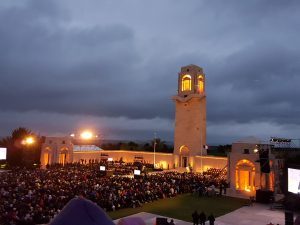
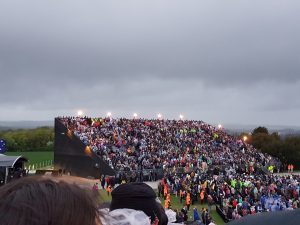
And, of course, the school. Surreal to visit a place I have researched, written about, and longed to see for so long. What you can’t see in the photos is that I had to stand in the rain to get these pics – but I didn’t care a jot!
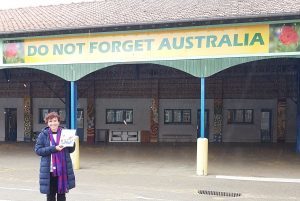
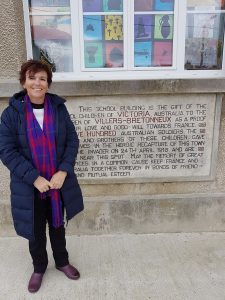
Only a taste of my visit because oddly, I think the experience was so emotional that, for once, I am lost for words when trying to describe it. But that doesn’t mean I will ever forget.
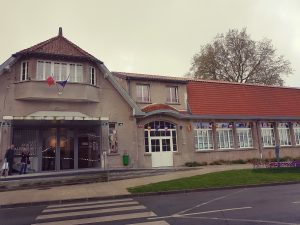
April 18, 2018
Do Not Forget
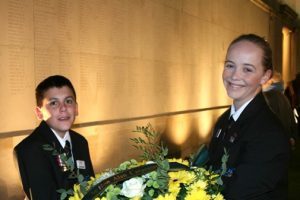
Tom helps lay a wreath in 2008
Ten years ago my son Tom was chosen to go on an amazing trip to France to visit the Western Front as part of the premier’s ANZAC Tour. When he attended the dawn service at Villers-Bretonneux I watched on television back at home, and marvelled not just at my son being on the other side of the world, but also at the amazing connection between the small village of Villers-Bretonneux and the children of Australia.
It was a story I had only recently come to know, but it was also a story I knew needed to be shared so that it wouldn’t be forgotten.
That was the day that I sat down and drafted the story which would become my picture book Do Not Forget Australia.
Ten years later, and at last it is my turn to visit Villers-Bretonneux for myself. On ANZAC Day next week I’ll be attending the dawn service at the Australian National Memorial at Villers-Bretonneux and later getting to see the school at the centre of the story for myself.
I’m excited. Watch this space for photos and a report.
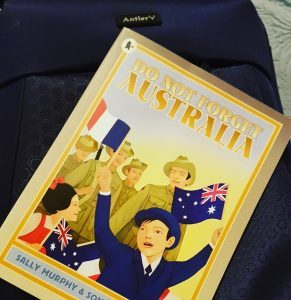
I’ve packed a copy of the book.
March 3, 2018
What I Read in February
February was a really busy month for me – lots of good stuff happening as well as just general busyness. So i guess I shouldn’t be surprised to realise that I only managed to read eight books this month, which is my lowest in a very long time. Lucky there were some good ones there. My favourite this month was, I think, The Extremely Inconvenient Adventures of Bronte Mettlestone (though it must be said that this book has an inconveniently length name!) which is great fantasy quest for younger readers (and older ones too!) in sumptuous hard cover with brilliant illustrations by the talented Kelly Canby.
As alwways, links to reviews, or to the book online, are included. Have a great month!
 Children’s Books
Children’s BooksAustralia’s Great War: 1918, by Libby Gleeson
The Subtle Knife, by Phillip Pulman
The Extremely Inconvenient Adventure of Bronte Mettlestone, by Jaclyn Moriarty
Pepsi the Problem Puppy, by Sandi Parsons
Stories of Life at Sydney Cove, by Susan E. Boyer
How to Feel Awesome Every Day, by Elly Awesome
Adult Fiction
The Hangman, by Jack Heath
Suddenly One Summer, by Fleur McDonald
February 8, 2018
Poetry Friday Roundup, and Some Terse Verse
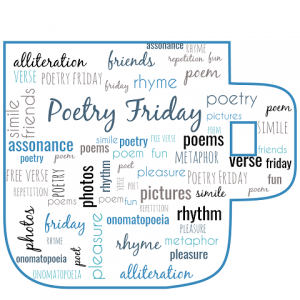 Welcome to Poetry Friday. I am really excited (and also slightly nervous) because, for the first time ever, I am hosting the Poetry Friday round up here on my blog. What does that mean? It means that other poetry enthusiasts from around the blogosphere will drop in here over the course of today and leave their links at the end of this post. You can then click through on each link and see ALL the poetry goodness on offer.
Welcome to Poetry Friday. I am really excited (and also slightly nervous) because, for the first time ever, I am hosting the Poetry Friday round up here on my blog. What does that mean? It means that other poetry enthusiasts from around the blogosphere will drop in here over the course of today and leave their links at the end of this post. You can then click through on each link and see ALL the poetry goodness on offer.
I mentioned being nervous about hosting (because I do like to do things right, and this is, as I said, my first time). I was also pretty nervous earlier this week, because I had to go to the dentist and get started on a root canal, something I had not been looking forward to, but which was necessary to get me out of the pain I was in.
The dentist was lovely, and tried hard to keep me calm and as comfortable as was possible while he was needling and drilling and prodding and whatever else he was doing. Me? I decided I would keep my mind busy with thoughts of anything other than what was happening in my mouth.
Maybe I could count backwards from a hundred? Nope. I kept losing count.
Maybe I could recite a poem in my head? Nope. My mind was blank.
Maybe I could make up a poem? Noooope. Actually, yes! But it would have to be a short one.
Haiku? Limerick? Ooooh. I had it! Terse Verse. Seemed to match both my mood (definitely terse) and the length of my concentration. My mind got very busy very quickly and, before I knew it I had ideas filling my mind (oooh, there’s a dental play on words), and had (almost) forgotten what the dentist was doing to me.
Almost, because unbeknownst to him, he was inspiring the verses. Afterwards, I couldn’t wait to get home and jot down what I’d come up with. So, here you have it, a series of Terse Verse in honour of my dentist:
To the Dentist Asking Me Questions While He Probes My Mouth
Mmmmfff grmmmmmf
To the Dentist Telling Me this is Going to Sting
No Joke, Poke
To the Dentist Making My Skull Vibrate With the Drill
Drilling’s Killing!
To the Dentist Telling Me I’m Doing Reaaaally Well
Why Cry?
To the Dentist Telling Me He’ll See Me Next Week for Another Round of Treatment
Great, mate!
(Insert sarcasm in the first word of that one!)
Goes to show you can write poetry about anything, anywhere. There is a form for every occasion, too.
If you are new to Terse Verse, my efforts might give you the idea – but if not, it’s simple. A Terse Verse has a generally quite long title (sometimes posed as a question), and then uses as few as two rhyming words to sum up the sentiment, or answer the question. Does it have to be as negative as mine? No And, just to prove that here’s a happier one
To the Snail I Met on My Morning Walk: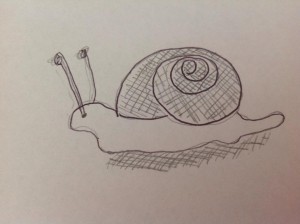
Swell shell!
Have you ever tried to write terse verse? Would love to see what you come up with. In the meantime, if you have a poetry post please share it in the Mr Linky below, and, whether you do or not, click through to see what my Poetry Friday friends are up to.
To My Friends on Poetry Friday
Rhyme time!
(All verses copyright Sally Murphy, 2018)
February 5, 2018
Teacher Tuesday: Creative Writing Using Looking Up
It’s Teacher Tuesday. Previous Teacher Tuesday posts have been quite long, offering whole units of work around one my books. But this week, to mix things up a bit, I am going to try a shorter post with just one activity. But it’s one of my all-time favourite creative writing activities, and it works well as an introduction to reading Looking Up as a class novel. 
So, here’s what you do. Before you read the novel, buy or make a set of birthday cards (I buy mine cheaply from discount stores), one for each member of the class, and write one for each student. You could write their name inside (ie Dear Tommy,….) OR, do what I have done in the past, and start each with Dear You, which means they can then be given out randomly. Also add a short message. When I have done this activity, I have used the same message that is used in Looking Up:
Happy birthday.
May all your dreams come true.
However, if you are feeling really creative, you might decide to write a different message in each card.
The fun bit is deciding who each card is from. The idea is that it is going to be a card from a complete stranger – someone the student has never met. They might be silly, fantastical, or completely random. Ideally, every student will get a card from someone different. Here are some ideas, which I have used:
The Monster Under Your Bed
Alan the Alien
Your New Next Door Neighbour
Officer Smith
Your Great Great Great Uncle Albert
Mrs Madge Longbottom
The Pot Plant Fairy
The Spider in Your Mailbox
So, a completed card might read:
Dear You,
Happy birthday.
May all your dreams come true.
Love,
Your Worst Nightmare
(Yes, I have used this one – the girl who got it had a lot of fun writing back.)
Now, for the activity.
Explain to the students that they are going to receive a birthday card, imagining that their birthday is coming up. Discuss: who generally sends birthday cards; what kinds of messages might they contain?
Give each student their sealed card. Make them wait to open it.
Before opening it, let them guess who it might be from.
Tell them they can open the envelope and remove the card, but not read it yet. Look at the outside of the card. Is it the sort of card they expected? Does it match their interests? Who might send them a card with a bunch of flowers/a race car/ etc on it?
Lastly, let them read the card, and share with neighbours.
As a class, have some students share their cards. Ask: Why would this person be writing to you? What would you do about it? Would you write back? Get help from a parent? Ignore the card?
Creative Writing. Either: Write a letter back to the sender, thanking them for the card and asking them about themselves. OR Write a scene where you meet the sender of the card.
After this activity, read the first two chapters of Looking Up. Make predictions about who ‘Grandad’ might be. Do students think he is really Pete’s Grandad or is it some kind of trick? What should Pete do about it? Why would his mum lie about Grandad being dead?
This activity can be adapted for students from year two through to year six. If you try it, I would love to hear how it goes.
More ideas for using Looking Up, can be found here or here.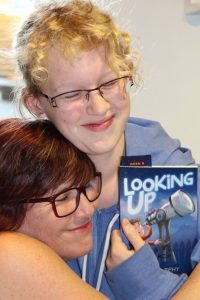
Looking Up, by Sally Murphy, with illustrations by Aska
Published by Fremantle Press, 2017
ISBN 9781925164572
Format, Paperback 72 pages, RRP $14.99
Available from good bookstores or here. Also available as an ebook.
February 3, 2018
What I Read in January
The first month of 2018 has been and gone (gosh, that was quick!), and it’s time to check in with what I read for January. I only managed one picture book – but it was my favourite read for the month. The Great Rabbit Chase is a delightful offering about, as the title suggests, the quest to capture an escaped rabbit. But perhaps it is the rabbit who is capturing the people – showing them a good time! Other highlights this month were Clan of Wolves, the second on the Tarin of the Mammoths series and, although it made me cry, and The Choke, by Sofie Laguna.
As always, if I have reviewed the book, I have linked to the review so you can see what I thought.
Picture Books
The Great Rabbit Chase, by Freya Blackwood 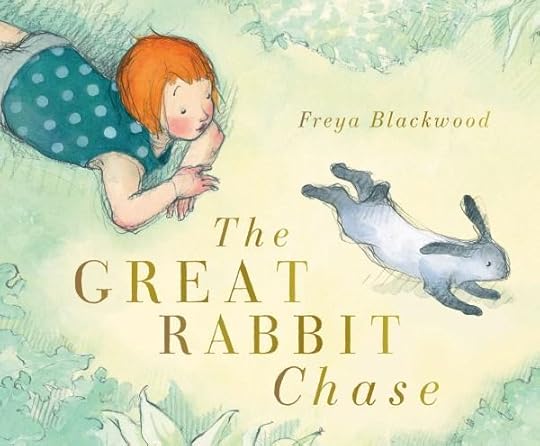
Younger Readers
Northern Lights, by Phillip Pullman
500 Minutes of Danger, by Jack Heath
The Cursed First Term of Zelda Stitch, by Nicki Greenberg
Jehan and the Quest of the Lost Dog, by Rosanne Hawke
Clan of Wolves, by Jo Sandhu
Young Adult Readers
A Semi-Definitive List of Worst Nightmares, by Krystal Sutherland
The Fifth Room, by A. J. Rushby
Fiction for Adults
The Twentieth Man, by Tony Jones
We That Are Left, by Lisa Bigelow
The Choke, by Sofie Laguna
Non Fiction
The Hate Race, by Maxine Beneba Clarke
The Prosperous Coach, by Steve Chandler & Rich Litvin
I’d love to hear what you thought of any of these books – or else, what it is you’ve been reading so far this year.
January 29, 2018
Teacher Tuesday: Using 1915 in a Year 6 Classroom
Welcome to my first Teacher Tuesday post for 2018 – and, of course, welcome to the new school year. If you have missed my previous Teacher Tuesday posts, links to those are at the end of this post, offering lots of ideas for using my books in your classroom. This week, I am sharing suggestions for using Australia’s Great War: 1915 in your year six classroom, though of course the activities could be adapted for an older or younger class as well.
Using 1915 in a Year Six Classroom
Australia’s Great War: 1915, by Sally Murphy 
Published by Scholastic Australia, 2015
ISBN: 9781743622483
Format 208 pp Paperback RRP $16.99 (Also available as an ebook)
Blurb: When Australia throws its support behind Britain in its fight against Germany, young teacher Stan Moore is one of the first to join up, swapping the classroom for adventure in Europe. But the 11th Battalion is sent with the newly formed Anzac Corp to Gallipoli where Stan is confronted by the hard lessons of war. Though conditions are dismal and death is everywhere, so is the humour and bravery that is the true spirit of Anzac.
Sally’s Recommended Grade Levels: Year 4 – Lower Secondary, but these suggestions focus on Year 6.
Themes/Topics:
Word War 1
Gallipoli
History
Family/Siblings
Friendship
Letter Writing
War Poetry
Curriculum Links and Activities
Identify and explore ideas and viewpoints about events, issues and characters represented in texts drawn from different historical, social and cultural contexts (ACELT1619)
Compare the ways that language and images are used to createcharacter, and to influence emotions and opinions in different types of texts (ACELT1621)
Recognise and analyse the ways that characterisation, events and settings are combined in narratives, and discuss the purposes and appeal of different approaches (ACELT1622)
Before Reading: Class or small group work – brainstorm knowledge about World War 1, and, particularly, Gallipoli. Start a class ‘fact’ wall, where facts about WW1 are added progressively during the unit. Have students verify facts, using internet sources and/or class library, and reference the source on their additions to the ‘fact’ wall. Information to consider: key dates of the war, key dates of Gallipoli campaign, countries involved, numbers of Australian who served, casualties, fatalities etc, geographic locations, famous people involved etc. Operation Click (available here) has useful fact sheets and worksheets.
Before reading – Examine front cover. Focus on the character pictured – the main character (Stan). Discuss – what kinds of people served in WW1? What would we expect Stan to be like – age, employment background, any special qualities etc. Examine rest of cover, including the photos and blurb. Journal writing, or discussion: From examining the cover, do you anticipate enjoying the book? Why/Why not? What do you know about Stan from the cover information? What do you think might happen to Stan in the story? Encourage students to give evidence from the cover and from their knowledge of WW1.
Before Reading – Focus on the concept of bravery/courage. What do these words mean? In groups, students to crate posters, providing a definition of bravery, and giving examples of what bravery might look – at war, and in everyday life.
During reading, focus on key moments of bravery, including the landing at Gallipoli (chapter five), Stanley helping Colin (pp. 67-68), Simpson (Chapter 9), Miles helping the Turk (Chapter 10), Stanley and others staying aboard the Southland (chapter 17). Encourage students to identify other kinds of courage: returning to Gallipoli after hospitalisation, using humour to get through, writing letters which don’t reflect just how bad things are etc.
After Reading: Groups to revisit their bravery posters, and create a second poster identifying instances of bravery from the book. Share posters with whole class, and discuss whether concepts of bravery have changed through reading the book. Use worksheets from Operation Click (here) to explore the concept of the ANZAC legend.
After Reading: Compare 1915 with other accounts of Gallipoli. Historic accounts, from newspapers and books can be found on Trove, and elsewhere, Contemporary nonfiction accounts in textbooks or online (here’s one to get you started), and fictional accounts are numerous – including the picture books listed here. Read and/or view a number of accounts, and have students compare by creating a table, focussing on: attitude to war, events focussed on, word choice, other aspects.
4.Reflect on ideas and opinions about characters, settings and events in literary texts, identifying areas of agreement and difference with others and justifying a point of view (ACELT1620)
5. Understand how language is used to evaluate texts and how evaluations about a text can be substantiated by reference to the text and other sources (ACELA1782)
After reading, discuss reactions to the book. Look back at predictions made about enjoying the book, and discuss whether the book met expectations.
Examine sample book reviews, and identify elements. (You can find many book reviews on the Reading Time website. There are also reviews of 1915 here and here).
Students to write their own review of 1915.
Alternatively, create a Booktalk or Book Trailer for the book. There is a sample Booktalk for 1915 HERE, and a Booktrailer for one of my other books, Toppling, HERE.
Plan, draft and publish imaginative, informative and persuasive texts, selecting aspects of subjectmatter and particular language, visual, and audio features to convey information and ideas (ACELY1725)
Reread Stanley’s poems (p. 77 & p. 169). Discuss why Stanley wrote poems, and why Charles Bean decided to put together the ANZAC book. Students to attempt their own poem about either another moment from the book (perhaps Miles’ death, or the landing at Galllipoli) OR about something difficult they have experienced.
Letter writing. Reread a selection of Stanley and Elizabeth’s letters. Write e letter from one of the characters after Stanley has left Gallipoli for the last time. OR Discuss how their letters differ from modern communication. Imagine they have mobile phones or email and write a text or email exchange between the two.
Other suggestions for using 1915 in your classroom include:
Make red poppies for ANZAC Day or Remembrance Day. Simple instructions can be found here.
Geography/HASS: Create a timeline for the Gallipoli campaign. Using a different colour or font, insert key events from the book.
Show students this real photo which features in the opening scene of the book.

Email the author(that’s me!) Your students can write to me through this website, and share their responses or ask questions.
Related Books
Meet the ANZACs, by Claire Saxby and Max Berry
Gallipoli, by Kerry Greenwood and Annie White
Simpson and His Donkey, by Frane Lessac and Mark Greenwood
Do Not Forget Australia, by Sally Murphy
Australia’s Great War: 1914, by Sophie Masson
Australia’s Great War: 1916, by Alan Tucker
Australia’s Great War: 1917, by Kelly Gardiner
Australia’s Great War: 1918, by Libby Gleeson
Mostly, I’d love to remind you that while I love to see my books used in classrooms, I also love to see kids just enjoying them. Reading a book should be pleasurable – whether it’s being used in the classroom or not. So allow your students to enjoy reading 1915
If you find this useful, or have any suggestions or comments, do leave a comment. And, if there is a particular book or year level or topic that you would like covered in a future edition of Teacher Tuesday, let me know.
Previous Teacher Tuesday posts include: Pearl Verses the World, Looking Up, Toppling, Roses are Blue, Do Not Forget Australia, The Sage Cookson Series, Snowy’s Christmas and The Floatingest Frog.
January 25, 2018
Poetry Friday: Back to School
Here in Australia the long summer holidays are coming to an end, and children and teachers are heading back to the classroom. So, I thought it might be nice to have a school themed post for Poetry Friday. A search through my poetry files found this one, written a few years ago (for the #postitnotepoetry challenge on Twitter), and written at a time when I still had school aged children:
Back to School
Six weeks ago 
I breathed a sigh
relieved
that school was over for the year.
Today
I sigh once more
relieved the holidays
have ended.
(Copyright Sally Murphy)
This year is the first year in 26 years that I do not have one or more children heading back to school, and so this year my feelings are a bit different. But the feeling I had every summer when I had school age children was pretty consistent – relieved at the start that the end-of-year scurry was over, and that we would have a break from routine, and time at home, and maybe a holiday somewhere; then, at the end of the holidays, a feeling of relief that we would all get back into a regular routine again. Though, if I’m honest, there was another feeling, one that is also here this year: the feeling that time moves just too quickly, and my babies were (are) growing up so fast!
This second one was also written a while back and, I promise, is very tongue-in-cheek,and not autobiographical.
I Hate It!
I hate school!
The kids are mean.
The classroom smells funny.
The lessons are hard
and recess is too noisy
We have to do sport
and the kids laugh
when I drop the ball.
The lunch orders are always cold
or soggy
or both
and the toilets
are leaky
and stinky.
I hate school
and I wish I could stay home
but the principal says
teachers should show up for work.
(Copyright Sally Murphy)
This of course sent me looking to see if I had a more positive poem to share. Surely not all my poems about school are negative? After all, I loved school when I was a child, so much so that I became a teacher and still spend lots of my working life in schools. Luckily, I found this one:
Preschool
We come each day
We sing.
We play.
We laugh.
We draw.
We laugh some more.
We take our turn.
We read.
We learn.
We listen.
We read.
We read read read.
We have such fun.
We jump.
We run.
We clap.
We dance.
And home we prance.
(Copyright Sally Murphy)
Ahhh preschool (or kinder, kindy, or prep, depending where you live!). But what about older kids? I had to wrack my brains for this, but then I remembered my verse novels and, my friend John (from Toppling) came through with his thoughts:
It’s not great having to head back to school 
after two weeks of holidays
but it’s cool being back with the gang.
Being in a group like ours
is great.
At recess
and lunch
and in class
you always have someone to sit with
or talk to
or just to hang out with.
You always get chosen for a team
during sport
and you have people
who remind you about homework
and notes
and even training after school.
Miss Timms calls us “the gigglers”
because on her first day
we couldn’t stop laughing.
It’s not a cool name
for a group of Year Six boys
but it sounds okay when Miss Timms says it.
(Copyright Sally Murphy)
Here’s to the Miss Timmses of the world, who are going to make kids giggle, and help them learn this year. And here’s to the Johns who can find the good things about school – and here’s too, to the kids, who maybe aren’t looking forward to school. I hope this is the year it gets easier for you! As for me, I’m glad school is going back because soon I will be out visiting schools and spreading a joy of reading and writing. My favourite part of my job!
Have a great Friday. The Poetry Friday roundup is being hosted by Carol at Beyond Literacy Link.
January 24, 2018
Book a Visit for 2018
Welcome back to the new school year. My regular Teacher Tuesday posts will start again from next week but, in the meantime, I thought I’d remind you that now is a wonderful time to think about booking an author visit session with me.
Based in Western Australia, but available to travel anywhere in Australia (or the world!), I can run  writing workshops, meet the author sessions, and teacher professional development.
writing workshops, meet the author sessions, and teacher professional development.
Want to inspire your students to write creatively? A narrative writing or poetry workshop might be the go.
Want to inspire them to read? Then book a meet the author session.
You can see my recommended sessions here, but I am happy to tailor to your needs.
2018 marks the 100-year anniversary of the end of Word War 1, and also the 100th anniversary of the Battle of Villers Bretonneux. My picture book Do Not Forget Australia focusses on this battle, and the extraordinary friendship it led to between France and Australia. I would love to visit your school and talk about this friendship – and the book.
Why book me? My goal in life is to spread a love of reading, and writing – and my sessions are energetic, fun and engaging. I’m also an experienced teacher, with a PhD in children’s poetry, so my energy is backed by depth of knowledge. What all this translates to is that an author visit will increase your students’ motivation and interest in reading and writing.
Want to know more? Contact me today.
January 16, 2018
Poetry Bootcamp- and PD By Stealth
Yesterday, I ran my first two writing workshops for 2018, presenting poetry writing boot camps as part of the City of Bunbury libraries school holidays program.

Characters come alive on the streets of Bunbury
I had a lot of fun using photos of some of Bunbury’s amazing street art as picture prompts to create poems.
Apart from the wonderful chance to meet and share with enthusiastic young writers, another thing that delighted me was that two teachers – one at each session – told me that they would be trying similar activities with their own classes when school goes back.
Hooray! Teacher PD by stealth! And on their holidays.
Which of course made me think of how much I love visiting schools (which I posted about last week), and how, having an author visit your classroom might not just motivate students to read and write, but can also act as a form of professional development for the teacher, demonstrating new ways of teaching writing, which is an area lots of teachers say they find challenging – something, as a teacher myself, I completely understand.
So, if you are wanting and extra reason to justify having an author visit your school or classroom, think of it as meeting PD requirements. And, if you’d like, you can add an after-school PD session to the program!
If you’d like me to visit in 2018, you can contact me here.



